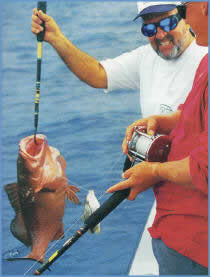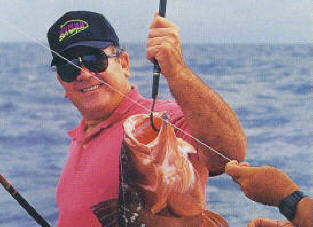May 16, 2011
By Max Branyon
Take a long ride out of Sebastian Inlet and dig into rod-bending action with big grouper and snapper.
By Max Branyon

Live bait on a ledge produced a red grouper for Ron Rincones and Dan Filakosky. |
The skipper cocked his head from side to side as he tried to watch three fishermen and a fishfinder simultaneously. He was busier than a one-eyed cat trying to watch two mice holes at the same time.
He eyed me as I dropped a live sailors choice almost 200 feet straight down on a rockpile about 30 miles east of Sebastian Inlet. When the sinker reached the bottom and I cranked a couple of turns, I knew that I had hooked either the bottom or a big grouper. When the bottom started moving, I knew it had to be a grouper—probably a warsaw.
“Get 'em up! Get 'em up! Get 'em up!” Capt. Ron “Rico” Rincones shouted, sounding like the trail boss on the old Rawhide western TV show.
“Reel! Reel! Reel!” he yelled.
We both knew that I had only seconds to get the fish turned and moving upward or it would swim back into the rocks—where even the 27-foot Sea Aye's turbo-charged diesel couldn't budge it. Then it would put the coup de grce on me and break off. Once I got the fish coming up, though, I knew that I could start pumping, but the first few seconds are critical and all I could do was crank like mad.
It felt like another warsaw, so I grunted and strained until I finally got the fish coming my way. Maybe a gray grouper, sow red snapper or a big amberjack, I thought. But, it had hit like a warsaw, a very forgiving fish. If an angler jerks the bait out of a warsaw's mouth, it will come back for a second helping—unlike grays and snappers, which tend to slink away after feeling resistance. This fish returned for leftovers.
Later, Capt. Rico explained another reason why he'd wanted me to get the fish up. “If it goes into the rocks and breaks off, it will turn the other fish off and shut down the bite at this site completely,” he said. I believed him because I had seen it happen a couple of times that day.
“If the fish pulls the hook and gets off right away, it usually doesn't shut down the bite, but if it breaks off or runs into a wreck or ledge, it shuts down the fishing,” Rincones said. “There's definitely a conversation taking place down there among the fish.” When that happens, the captain just puts the boat in gear and throttles on to the next of his many honeyholes.
After I pumped and reeled the warsaw to the stern, the skipper lipped it with his gaff, hauled it aboard, quickly measured it, tagged it and then released it. Before the day was over, we would catch, tag and release five more warsaws and keep our limit of one per boat. However, one is enough if it weighs 20 pounds or more, especially if you have a couple of nice red grouper and an amberjack in the chiller for dinner to go along with it.
Along much of the Florida coastline, warsaw grouper are associated with very deep water. They're also considered pretty rare. I've caught them on electric reel gear in 500 feet in the Gulf of Mexico. But here, on the rocky ledges off Sebastian Inlet, we were fishing at half that depth and with no power assistance. Just elbow grease and determination. Our success says something about the incredible variety available to anglers fishing these waters.
Bottom fishermen out of Sebastian and nearby Fort Pierce and Canaveral have access to a wealth of fishy structure. There are wrecks, the 21 Fathom Ridge, 27 Fathom Ridge, and an area of steep bottom structure in about 250 feet known alternately as the Cones or the Steeples. Deepwater fishing around the Cones is especially good. This limestone fault extends from Fort Pierce to due east of Daytona Beach. The formations, some of which have live coral, vary from 15 to 90 feet in height.
Also of interest to anglers are Bethel Shoals, the Northeast Grounds, the 50-Foot Ridge and numerous other ridges and bars. Divers have found petrified wood on the 27-Fathom Line and some experts speculate that this could have been the old Florida coastline thousands of years ago.
All these spots and others are listed on Waterproof Chart #124F, available at local tackle shops or from International Sailing Supply in Punta Gorda, 1-800-423-9026. A few more sites worth checking out are included with this article, too. The fishing grounds closest to Sebastian seem to get less pressure than those off Daytona Beach and Port Canaveral to the north and Fort Pierce and Stuart to the south. In fact, on our last trip out, we didn't see a single bottom-fishing boat, though we did see some trolling boats that had come all the way up from Stuart to catch sailfish.
Joining us on this bottom-fishing slugfest were Walt Hudson and Dan Filakosky. Filakosky is a husky young man who was once skipper of a partyboat out of Port Canaveral. Hudson, whose specialty is deep-jigging, has caught more bottom fish than any recreational angler I know. When he is not fishing, he is talking fishing or rigging baits at Jumbo Sports in Winter Park. Rincones, a 30-year veteran skipper who lives in Palm Bay and charters out of Sebastian, kept us on fish all day. He used a 10-inch, 1,000-watt color depthfinder and a loran to locate and identify fish.

Walt Hudson's chunky red grouper is destined for the dinner table. |
We caught grouper weighing between 20 and 30 pounds, amberjack to 40 pounds, and a shark. All were released except three grouper (a warsaw and two reds) and an amberjack.
The limit of one warsaw per boat per trip has helped these big groupers make a real comeback, according to Rincones. He has caught, tagged and released warsaw grouper that have been caught, tagged and released numerous times. His record was a warsaw that had been caught and tagged eight times. He tagged and released it again.
The typical bottom fisherman's bag off Sebastian would include scamp, gray (gag) grouper, speckled hind (Kitty Mitchell), a few black grouper, quite a few red grouper, lots of red snapper and amberjacks, and an occasional big mangrove or lane snapper to spice things up.
Big-fish tackle on the Sea Aye starts with a 6/0 reel spooled partway with 100-pound-test monofilament and, for the last 150 yards,
80-pound Spiderwire, a spectra-type line which has the diameter of 25-pound test. When the current is running, the thinner line lets an angler use less weight to reach bottom. It is also sensitive, allowing anglers to feel strikes better. The typical rod is a fast-taper 7-footer with a very solid backbone and a light tip—useful for red snapper fishing, where the bite is often more subtle.
Basic terminal rigging consists of a 10- to 16-ounce egg sinker free to slide on the main line, stopped by a plastic bead and swivel. On the other end of the swivel is a leader of 100-pound-test monofilament. Baits are usually croakers, spots or pinfish, caught inshore. Others (tomtates, grunts, etc.) are caught on ledges and wrecks in 60 to 90 feet of water on the way out to the grouper and snapper grounds. On the deeper bait spots, drop a sabiki rig with small hooks to the bottom. Reel up and you should have baitfish on the line if they are there. If you don't feel anything, jig it a couple of times. If nothing happens this time, drop it down again and repeat the procedure.
On the grouper grounds, Rincones advises fishermen not to bump the sinker on the bottom—it seems to spook fish. Once the lead hits bottom on the initial drop, crank it up a few feet and hold on for action, rodtip up at the 10 o'clock position. You'll have an edge when a grouper or snapper takes the bait, especially when using live baitfish. When you feel the fish bump the bait, drop the tip until the rod is pointed straight down so that the fish doesn't feel any resistance.
“When your rod is almost vertical to the water, then you start cranking like crazy to get the fish away from structure,” Rincones said. “Don't try to set the hook. Just reel. Crank—don't yank!” After the angler gets the fish coming his way, then he can start pumping and reeling.
The skipper told about one of his clients, a 6-foot, 6-inch man who was as strong as a bull. When Rincones took him out to do some serious bottom fishing, the mountaineer had never caught anything larger than a 2-pound catfish back home in the streams of Kentucky and West Virginia. When the man latched onto a giant warsaw, Rico began coaching: “Reel! Reel! Reel!”
The fisherman took his advice, but the huge fish headed straight for the structure. Although the angler gave it all he had, and was so strong he bent the handle on a 6/0 reel, the giant fish finally broke off. Then, the man with the bent reel handle in his hand turned to the captain and said, with as much emotion as he could muster, “Shooot Far! Did you see that critter kick my butt?”
It was all the captain could do to keep a straight face.
Rincones has fun and catches plenty of big fish, but his type of bottom fishing is not for the faint of heart. It requires strength and stamina. After a full day of bottom fishing, anglers return to port with ample fish in the box, but feeling like they have had a good workout. And they usually sleep well that night. An average day for Capt. Rico with three or four anglers is 10 to 12 grouper, six snappers and a couple of amberjacks along with a cobia or two. On a good day, when all the elements come together, weather, seas, currents, fish feeding, etc., he may double those numbers. He takes plenty of fish home, but he releases a lot, too. “I believe in conservation,” he said. “Take a few big fish home and leave some for tomorrow.”
Whether on board a charterboat or in your own vessel, when you arrive at the fishing grounds and locate the fish, you are in for some back-stretching exercise and lots of fun when the grouper, snapper and amberjacks turn on. Lots of fish will be in the 30-pound range, but there are some tackle busters down there that will top 100 pounds. It's just a matter of getting them up.
Capt. Rico has had great success at coaching his clients on how to hook, fight and get fish to the boat. His only defeat has been trying to teach his parrot, Tuffy, how to speak nautical lingo. He's tried to tutor him into saying: “Ahoy! Crank—don't yank!” and “Reel! Reel! Reel!” but so far he's heard only: “Pretty bird” and “Huh?”
FS
